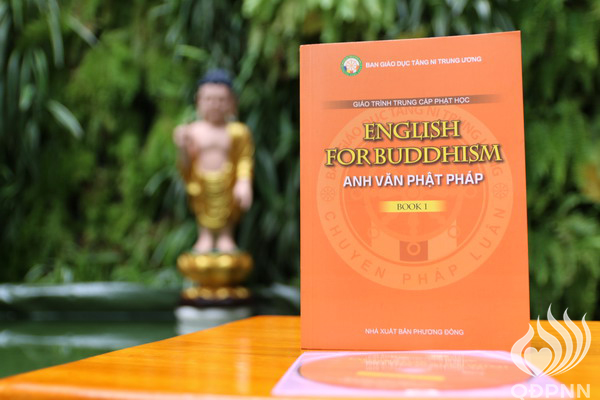1.READING
Listen to the recording of the following text. Practice reading aloud sentence by sentence after the recording.
- People often need to remember what they love and respect in a visual form. In this way shrines of Buddha are usually arranged at monasteries or at Buddhist home. At the centre of the shrine, there is an image of the Buddha. This image may be made of a variety of materials such as marble, gold, wood or clay. The image is a symbol that helps people to remember the qualities of the Buddha
- The shrine may also have a volume of Buddhist scripture to represent the Dharma. Some shrines may display images or photographs of Buddhist monks and masters to represent the Sangha.
- When Buddhists stand before a shrine, those objects help to remind them of the qualities of the Buddha and the Sangha. This inspires them to work toward cultivating these qualities in themselves.
2. WORDS TO LEARN
Be made of (v): làm bằng (vật liệu)
Clay (n) [klei]: đất sét
Cultivate (v) [‘kʌltiveit]: tu dưỡng, nuôi dưỡng
Cultivation (n) [kʌlti’vei∫n]
Display (v) (n) [dis’plei]: trưng, bày
Gold (n) [gould]: vàng
Inspire (v) sb to do st [in’spaiə]: tạo cảm hứng cho ai làm cái gì
Inspiration (n)[inspə’rei∫n]: sự cảm hứng; nguồn cảm hứng
Marble (n) [‘mɑ:bl]: đá hoa cương
Master (n) [‘mɑ:stə]: thầy, sư phụ
Material (n) [mə’tiəriəl]: chất liệu, vật chất
Arrange (v) [ə’reindʒ]: sắp xếp, sắp đặt, sửa soạn
Monastery (n) [‘mɔnəstəri]: tăng viện
Nunnery (n) [‘nʌnəri]: ni viện
Quality (n) [‘kwɔliti]: phẩm chất
Remind sb of st (v) [ri’maind]: nhắc nhở ai nhớ về (đến) cái gì
Respect (v) [ri’spekt]: tôn trọng
Scripture (n) [‘skript∫ə]: kinh
Shrine (n) [∫rain]: gian thờ, miếu
Symbol (n) [‘simbəl]: biểu tượng
Symbolize (v) [‘simbəlaiz]: tượng trưng
Variety (n) [və’raiəti]: sự đa dạng
Vary (v) [‘veəri]: khác nhau
Visual (a) [‘vi∫uəl]: có thể nhìn thấy bằng mắt
Wood (n) [wud]: gỗ
Image (n) [‘imidʒ]: tượng, hình tượng, hình ảnh
Represent (v) [repri’zent]: tượng trưng cho; biểu trưng
3. QUESTIONS
Answer the following questions with information from the text.
1 Why are altars of Buddha arranged at monasteries or at home?
2 What can be found in the center of the altar?
3 What does Buddha images symbolize?
4 What else do people arrange in an altar?
5 What do these objects represent?
6 Why is an altar of Triple Gem important to Buddhists?
4.Practice asking and answering those questions with a partner, book closed.
TRANSLATION
HÌNH TƯỢNG VÀ ĐIỆN THỜ PHẬT GIÁO
Mọi người thường cần tưởng nhớ đến những gì họ yêu mến và tôn kính thông qua hình tượng trực quan. Cũng vậy gian thờ Phật thường được thiết lập tại chùa chiền hay tại tư gia của Phật tử.
Chính giữa gian thờ, có hình tượng Phật. Hình tượng Phật có thể làm bằng nhiều chất liệu khác nhau như đá, vàng, gỗ hay thạch cao. Hình tượng Phật là biểu tượng giúp mọi người nhớ đến phẩm hạnh của đức Phật.
Gian thờ còn có thể có một bộ kinh tượng trưng cho Pháp. Vài gian thờ còn để tranh ảnh chư tăng hay thầy tổ tượng trưng cho Tăng.
Khi Phật tử đứng trước gian thờ, những hình tượng này nhắc họ nhớ đến những phẩm hạnh của đức Phật và chư Tăng. Điều này thúc đẩy họ hướng đến tu tập những phẩm hạnh này nơi tự thân họ.
PRACTICE
Translate the following sentences into Vietnamese.
1 The image or statue of the Buddha could be made in various materials and it makes people remember the qualities of the Enlightenment.
2 This pagoda preserves a rare volume of Buddhist scriptures which are written on palm leaves.
3 Practising the Buddha’s teachings is the right way to respect the Enlightenment.
4 My mother always reminds me to pay respects to monks and nuns as they are a symbol of simple and pure life.
Translate the following sentences into English.
1 Chính giữa Phật điện là tượng Đức Bổn Sư Thích Ca Mâu Ni. Đức Phật là hiện thân của từ bi và trí tuệ.
2 Mọi người phải giữ trang nghiêm và tôn trọng nội quy khi vào tự viện.
3 Họ đang trưng bày một bộ kinh Phật cổ đã có từ cách đây mấy trăm năm.






Discussion about this post